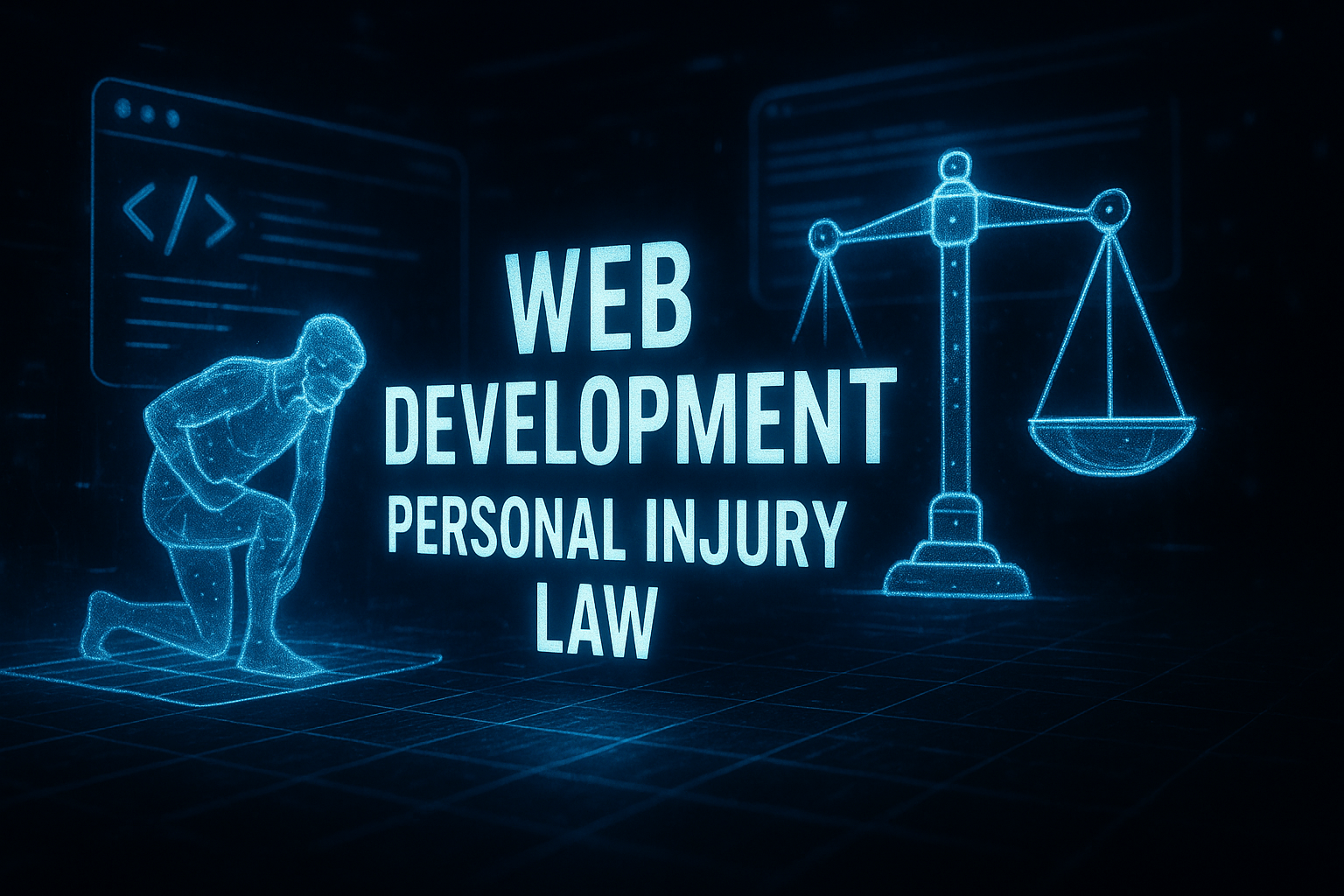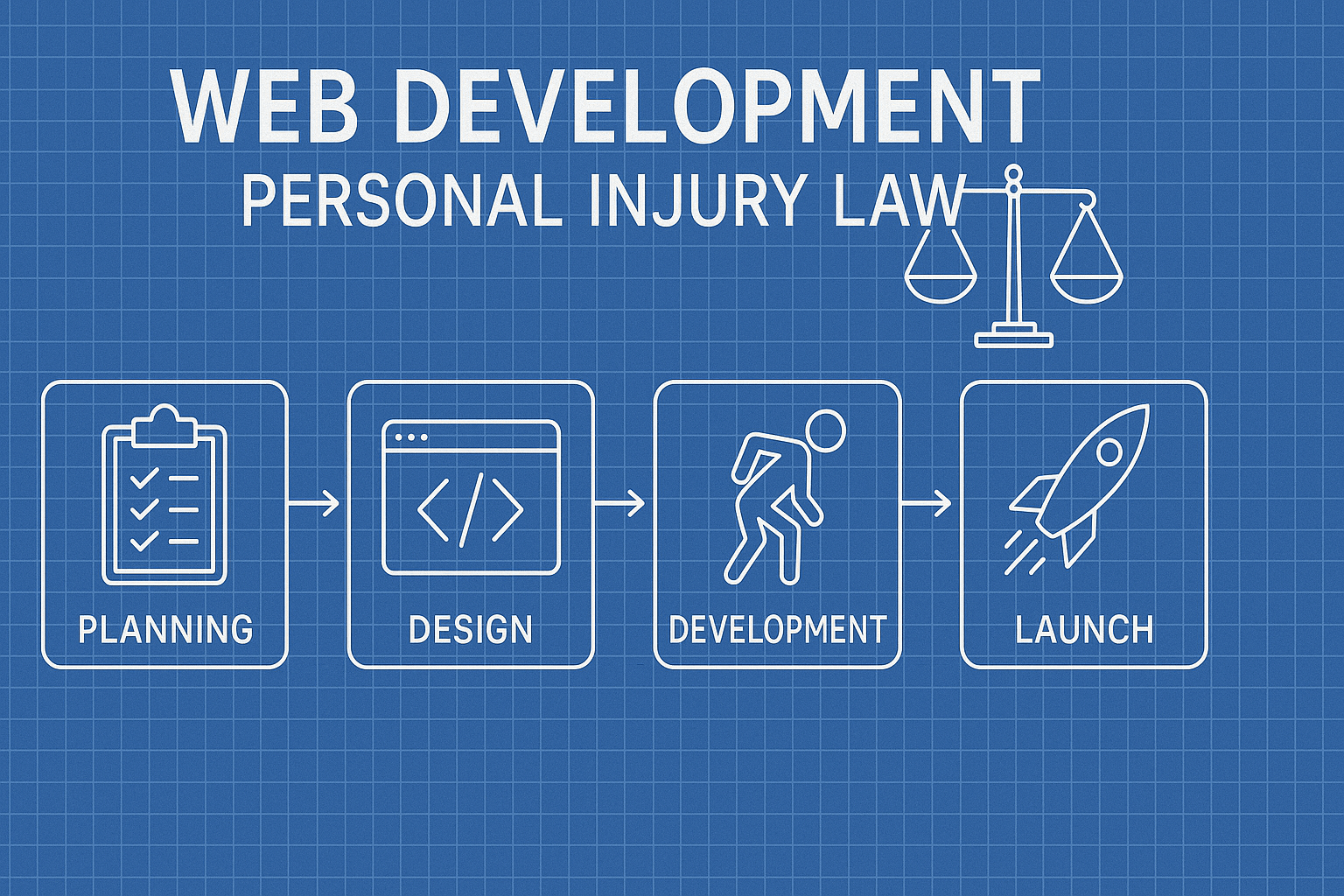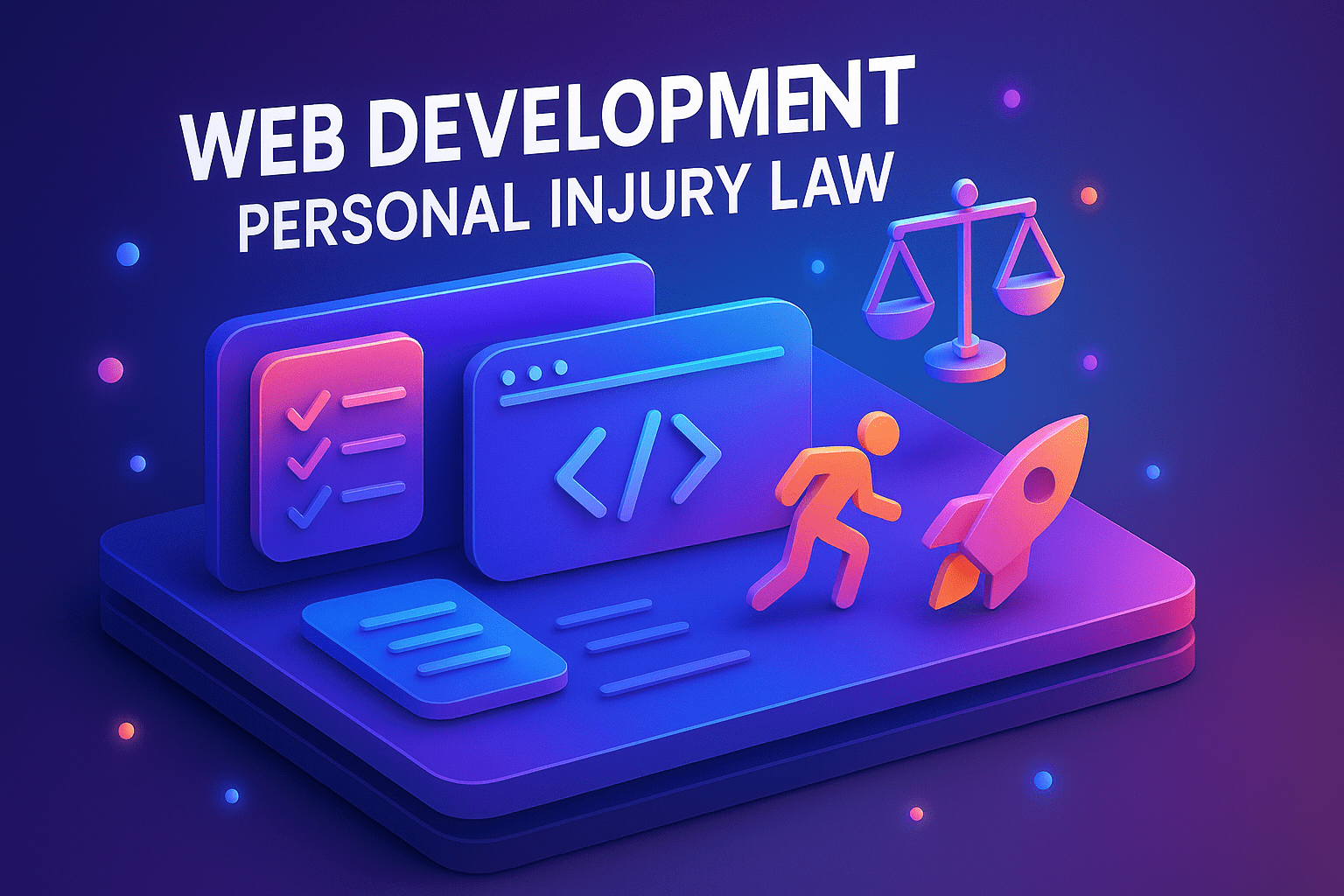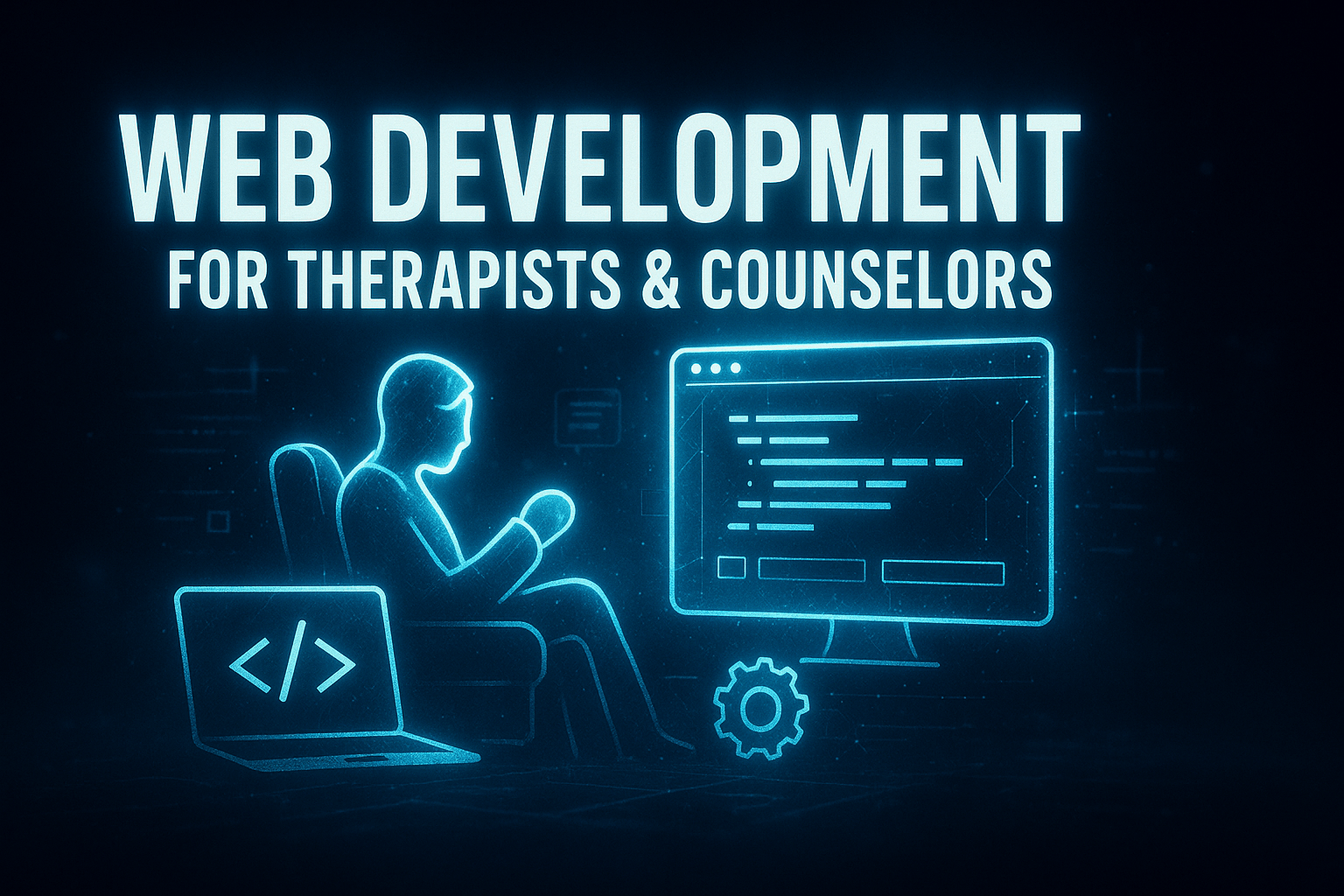Web Development for Personal Injury Law Firms: Convert More Clients with Strategic Design & Performance
by Design Delulu Editorial · October 17, 2025

Smart, fast, and measurable. Here's how Web Development helps Personal Injury Law win.
When someone searches for a personal injury attorney, they're often in crisis mode—dealing with medical bills, insurance companies, and physical pain. Your website has seconds to build trust, communicate expertise, and make contacting you effortless. Yet most personal injury law firm websites fail this test: slow load times frustrate mobile users, confusing navigation buries contact forms, and generic messaging fails to differentiate your firm from dozens of competitors.
Strategic web development changes this equation entirely. A well-engineered site doesn't just look professional—it becomes your most effective client acquisition tool, working 24/7 to qualify leads, showcase case results, and convert visitors into consultations. The difference between a $5,000 template and a $50,000 custom development isn't just aesthetics; it's measurable ROI through higher conversion rates, better search rankings, and streamlined intake processes. For personal injury firms where a single case can generate $50,000+ in fees, even a modest improvement in conversion rate delivers exponential returns. This guide breaks down exactly how modern web development drives both immediate wins and compounding long-term growth for personal injury practices.

Why Personal Injury Law Firms Need Specialized Web Development
Personal injury law operates in one of the most competitive digital landscapes. Potential clients research multiple attorneys before making contact, often while dealing with physical pain and emotional stress. Your website must immediately answer three critical questions: Can you handle my specific case type? Have you won cases like mine? How quickly can I talk to someone?
Generic web development misses these nuances entirely. A standard business site prioritizes brand storytelling; a personal injury site must prioritize urgent action and social proof. Visitors need prominent case results, attorney credentials, and multiple contact pathways—all optimized for mobile devices where 70%+ of initial searches happen.
The technical stakes are equally high:
- Page speed directly impacts case acquisition - Google data shows 53% of mobile users abandon sites taking over 3 seconds to load, meaning slow servers literally cost you clients
- Local SEO determines visibility - Personal injury is geographically constrained; technical SEO errors that hurt local rankings make you invisible to high-intent searchers
- HIPAA and privacy compliance aren't optional - Intake forms collecting sensitive information require secure transmission, proper data handling, and clear privacy policies
- Accessibility affects both reach and liability - ADA compliance prevents lawsuits while expanding your potential client base to people with disabilities
Specialized web development for personal injury law addresses these requirements systematically, building sites that function as lead generation machines rather than digital brochures.
Core Components of High-Converting Personal Injury Websites
Effective personal injury web development integrates multiple technical and strategic elements. Here's what separates conversion-focused sites from template mediocrity:
Strategic Architecture & User Flows
Every page should guide visitors toward conversion with minimal friction. Primary conversion paths include: phone calls, contact form submissions, live chat inquiries, and downloadable case evaluation forms. Secondary paths support trust-building through attorney bios, case results, and educational content.
Critical pages requiring custom development:
- Homepage - Hero section with clear value proposition, trust indicators (years in practice, cases won, settlements obtained), prominent CTA, and case type navigation
- Practice area pages - Dedicated pages for car accidents, slip-and-fall, medical malpractice, wrongful death, etc., each optimized for specific search intent
- Attorney profiles - Credential-rich pages showcasing expertise, with personal stories that build emotional connection
- Case results - Filterable, searchable database of past settlements and verdicts that serve as powerful social proof
- Multi-step intake forms - Conditional logic forms that qualify leads while collecting case details, reducing staff time on unqualified inquiries
Performance Optimization That Wins Cases
Technical performance isn't just about user experience—it's about competitive advantage. When multiple law firms appear in search results, the fastest site often wins the client.
Essential performance optimizations:
- Server-side rendering or static site generation for sub-2-second initial page loads
- Image optimization using next-gen formats (WebP, AVIF) with responsive sizing and lazy loading
- CDN implementation to serve content from geographically distributed servers
- Database query optimization for case results and blog post retrieval
- Caching strategies at multiple levels (browser, CDN, application, database)
Benchmark target: Lighthouse score of 90+ on mobile, Core Web Vitals passing all metrics, and sub-3-second fully loaded time on 4G connections.
Mobile-First Development
With the majority of initial searches happening on smartphones—often immediately after an accident—mobile optimization isn't secondary, it's primary. This means designing for thumb-friendly navigation, readable typography without zooming, and prominent click-to-call buttons.
Mobile-specific considerations:
- One-tap phone dialing without requiring form fills
- Simplified navigation with hamburger menus and sticky headers
- Vertical scrolling layouts that work with one-handed use
- Form fields with appropriate input types (tel, email) that trigger correct mobile keyboards
- Progressive web app capabilities for offline access and home screen installation
Conversion-Optimized Forms & CTAs
Contact forms are where technical execution meets business outcomes. Poor form design kills conversions; excellent forms pre-qualify leads while making submission effortless.
Best practices for personal injury intake forms:
- Multi-step design - Break long forms into 3-4 steps to reduce perceived friction and increase completion rates
- Conditional logic - Show/hide fields based on case type to collect relevant information without overwhelming users
- Progress indicators - Visual feedback showing users how close they are to completion
- Smart validation - Real-time error checking that guides users without frustrating them
- Multiple submission options - Offer form, phone, text, and live chat to meet different user preferences
- Automatic lead scoring - Backend logic that flags high-value cases for immediate follow-up

Technical SEO & Analytics Infrastructure
Personal injury keywords are expensive in paid search ($50-150 per click) and competitive in organic search. Technical SEO determines whether you compete effectively or remain invisible.
Local SEO Technical Foundation
Personal injury law is inherently local—clients need attorneys licensed in their jurisdiction. Technical implementation must reinforce this geographic relevance:
- Schema markup - LocalBusiness, LegalService, Attorney, and Review schema tell search engines exactly what you offer and where
- Location pages - Dedicated pages for each service area with unique content, embedded maps, and local testimonials
- NAP consistency - Name, address, phone number must match exactly across your site, Google Business Profile, and directory listings
- Mobile usability - Google's mobile-first indexing means mobile performance directly affects all rankings
- Core Web Vitals - Page experience signals (LCP, FID, CLS) influence search visibility
Measurement & Attribution
Web development should include comprehensive analytics infrastructure from day one. You can't optimize what you don't measure.
Essential tracking implementation:
- GA4 with enhanced measurement - Track scroll depth, video engagement, file downloads, and outbound clicks automatically
- Server-side tagging - Improve data accuracy and page speed by processing analytics server-side rather than client-side
- Call tracking integration - Dynamic phone numbers that attribute calls to specific marketing sources
- Form tracking - Capture partial submissions, abandonment points, and completion funnels
- CRM integration - Pass web lead data directly into case management systems with source attribution
- Conversion value tracking - Associate lead quality scores with traffic sources to calculate true ROI
Build custom dashboards in Looker Studio or similar tools that answer specific questions: Which practice area pages convert best? What content drives qualified leads? How do organic vs. paid visitors differ in case quality?
Attribution Modeling for Multi-Touch Journeys
Personal injury clients rarely convert on first visit. They research multiple firms, read reviews, and return several times before contacting you. Attribution modeling reveals the true value of each marketing channel:
- First-touch attribution - Credit the initial traffic source that introduced the client to your firm
- Last-touch attribution - Credit the final interaction before conversion
- Linear attribution - Distribute credit equally across all touchpoints
- Time-decay attribution - Give more credit to recent interactions
- Position-based attribution - Emphasize both first and last touch with reduced credit to middle interactions
Choose the model that matches your buyer journey and stick with it for consistent measurement. Most personal injury firms benefit from position-based models that recognize both awareness-building (SEO, content) and conversion-driving (retargeting, branded search) channels.
Security, Compliance & Trust Signals
Personal injury websites collect sensitive information—accident details, medical conditions, insurance data. Security isn't just good practice; it's ethical responsibility and legal requirement.
Technical Security Requirements
- SSL certificates - HTTPS encryption is mandatory for any site collecting form data; also required for good search rankings
- Form encryption - Use TLS 1.3 for data transmission and encrypt stored form submissions at rest
- Regular security audits - Scan for vulnerabilities, update dependencies, and patch CMS platforms promptly
- DDoS protection - Implement rate limiting and use CDN services that include DDoS mitigation
- Secure hosting - Choose hosting providers with security certifications and regular backups
- Two-factor authentication - Require 2FA for administrative access to prevent unauthorized site changes
Privacy & Compliance
While HIPAA doesn't typically apply to attorney-client communications, privacy best practices build trust and prevent issues:
- Clear, accessible privacy policy explaining data collection and use
- Cookie consent management for GDPR/CCPA compliance
- Data retention policies that specify how long information is stored
- Opt-in for marketing communications rather than pre-checked boxes
- Secure disposal procedures for old lead data
Visual Trust Signals
Beyond technical security, your site must look trustworthy. Visitors make snap judgments about credibility within seconds:
- Professional photography - High-quality attorney headshots and office images signal investment and success
- Third-party badges - Display awards, certifications, bar memberships, and review site ratings
- Case results - Specific settlement amounts and case descriptions (with client permission and appropriate disclaimers)
- Video testimonials - Real clients sharing their experiences builds more trust than text alone
- Media mentions - Press coverage, speaking engagements, and published articles demonstrate authority

Content Management & Scalability
Personal injury firms need to publish content regularly—legal updates, safety tips, case studies, FAQ articles. Your CMS should make this easy for non-technical staff.
CMS Selection Criteria
Different content management systems fit different needs:
- WordPress - Most popular, extensive plugin ecosystem, SEO-friendly, but requires regular maintenance and security updates
- Webflow - Visual builder with clean code output, great for marketing sites, limited blog functionality
- Craft CMS - Flexible, secure, excellent for custom content types, steeper learning curve
- Headless CMS (Contentful, Sanity) - Separates content from presentation, enables omnichannel publishing, requires more technical expertise
For most personal injury firms, WordPress or a headless solution paired with a modern frontend framework (Next.js, Gatsby) offers the best balance of flexibility, performance, and editability.
Scalable Content Architecture
As your firm grows, your website should grow with it—new attorneys, practice areas, and office locations shouldn't require full redesigns. Build scalability through:
- Component-based design systems - Reusable UI components (hero sections, team cards, testimonial blocks) that maintain consistency
- Dynamic page generation - Template-driven pages for attorneys, practice areas, and locations that pull from structured data
- Automated internal linking - Logic that connects related content (practice area → relevant blog posts → case results) without manual updating
- Centralized content management - Single source of truth for attorney bios, office hours, and contact information used across multiple page types
Integration With Business Systems
Your website shouldn't exist in isolation—it should connect seamlessly with your firm's operational tools.
CRM & Case Management Integration
When a lead submits your intake form, that data should flow automatically into your case management system. Integration benefits:
- Eliminate manual data entry and associated errors
- Enable instant follow-up workflows and automatic task creation
- Maintain source attribution to measure marketing ROI accurately
- Create unified client records from first website visit through case resolution
Common integrations include Clio, MyCase, Filevine, and Salesforce, typically implemented via APIs or middleware platforms like Zapier.
Communication Tools
Modern personal injury sites offer multiple contact methods beyond basic forms:
- Live chat - Real-time conversations during business hours, chatbot responses after hours, with transcripts sent to email
- SMS intake - Text-to-contact options for mobile users who prefer texting over calling
- Video consultations - Integrated booking systems for virtual meetings with embedded calendar availability
- Client portals - Secure login areas where existing clients access case updates, documents, and billing information
Ongoing Optimization & Maintenance
Launching your website is the beginning, not the end. High-performing personal injury sites undergo continuous improvement based on data and user feedback.
Conversion Rate Optimization Process
Systematic CRO follows this cycle:
- Analyze - Review analytics, heatmaps, session recordings to identify friction points
- Hypothesize - Develop testable theories about what changes will improve conversions
- Test - Run A/B tests on high-traffic pages (homepage, top practice areas)
- Implement - Roll out winning variations site-wide
- Iterate - Repeat the cycle focusing on the next highest-impact opportunity
Common high-impact tests for personal injury sites:
- CTA button text ('Free Consultation' vs. 'Get Started' vs. 'Discuss Your Case')
- Form length (single page vs. multi-step)
- Hero section focus (attorney credibility vs. case results vs. empathetic messaging)
- Social proof placement and format
- Mobile phone button prominence and positioning
Technical Maintenance Requirements
Websites require ongoing maintenance to remain secure, fast, and functional:
- Security updates - Core CMS, theme, and plugin updates applied within 48 hours of release
- Performance monitoring - Weekly checks of Core Web Vitals, page speed scores, and uptime
- Broken link checks - Monthly audits to identify and fix 404 errors that hurt SEO and user experience
- Backup verification - Regular testing of backup restoration to ensure recovery capability
- Analytics review - Weekly dashboard checks and monthly deep dives to identify trends and opportunities
- Content updates - Refreshing statistics, case results, and attorney information to maintain accuracy
Choosing a Web Development Partner
Personal injury web development requires specialized expertise—understanding both technical best practices and the unique needs of legal marketing. When evaluating developers, ask:
- Do they have personal injury law experience? - Review their portfolio for similar projects and ask for case studies with specific metrics
- What's their approach to conversion optimization? - Look for developers who think beyond aesthetics to business outcomes
- How do they handle ongoing optimization? - One-and-done builds miss opportunities; look for partners offering continuous improvement
- What's their technical stack? - Modern frameworks and tools deliver better performance and maintainability
- Can they integrate with your existing systems? - CRM, call tracking, and marketing automation connections are essential
- What does their support model look like? - Understand response times, update procedures, and emergency protocols
Quality web development isn't cheap—expect $15,000-75,000 for custom personal injury sites depending on complexity, integrations, and content volume. Template-based solutions cost less upfront ($5,000-15,000) but often require expensive customization later. View this as investment, not expense: a site that converts 5% instead of 2% pays for itself quickly when average case values exceed $30,000.
Implementation Timeline & Process
Personal injury website projects typically span 8-16 weeks from kickoff to launch. Here's a realistic timeline:
Weeks 1-2: Discovery & Strategy
- Stakeholder interviews to understand firm goals, differentiators, and target cases
- Competitive analysis of top-ranking firms in your market
- User research and persona development
- Content inventory and gap analysis
- Technical requirements documentation
Weeks 3-5: Design & Information Architecture
- Sitemap development and page flow diagrams
- Wireframes for key templates (homepage, practice areas, attorney profiles)
- Visual design concepts exploring brand expression
- Design system creation with reusable components
- Content strategy and messaging framework
Weeks 6-10: Development & Content
- Frontend development with responsive layouts and interactions
- Backend/CMS setup with custom fields and content types
- Third-party integrations (CRM, analytics, chat, call tracking)
- Content writing and optimization for priority pages
- Photography and video production as needed
Weeks 11-12: Testing & QA
- Cross-browser and device testing
- Performance optimization and speed testing
- Security audit and penetration testing
- Accessibility testing against WCAG standards
- Form testing and CRM connection verification
Weeks 13-14: Pre-Launch & Training
- Content loading and final page builds
- Staff training on CMS and content updates
- Analytics implementation and verification
- 301 redirect mapping from old site URLs
- DNS and hosting configuration
Weeks 15-16: Launch & Optimization
- Soft launch with monitoring and bug fixes
- Search engine resubmission and indexing verification
- Post-launch performance monitoring
- Initial optimization based on early user behavior data
This timeline assumes timely client feedback and content provision. Delays in decision-making or content creation extend the schedule proportionally.
Measuring Success: KPIs That Matter
Track metrics that connect directly to business outcomes, not vanity metrics. Essential KPIs for personal injury websites:
Acquisition Metrics:
- Organic search traffic growth - Month-over-month increases in search visibility
- Keyword rankings - Position changes for target practice area + location terms
- Local pack appearances - Visibility in Google's local 3-pack for key searches
Engagement Metrics:
- Average session duration - Time spent on site indicates content relevance
- Pages per session - Multi-page visits suggest strong engagement
- Bounce rate by page type - High bounces on practice area pages signal content problems
Conversion Metrics:
- Contact form submissions - Primary conversion goal for most firms
- Phone calls from website - Often the highest-quality lead source
- Live chat conversations - Increasingly popular contact method
- Conversion rate by traffic source - Reveals which channels deliver best leads
Business Outcome Metrics:
- Lead-to-client conversion rate - Percentage of web leads becoming signed cases
- Average case value by source - Reveals true ROI when some channels attract higher-value cases
- Cost per signed case - Total website investment divided by new clients acquired
- Lifetime value of web-sourced clients - Accounts for referrals and repeat business
Review these metrics weekly at the tactical level (what's working this week?) and monthly at the strategic level (what trends are emerging?). Quarter-over-quarter comparisons reveal whether your site is improving or stagnating.
Future-Proofing Your Investment
Web technology evolves rapidly. Build sites that can adapt without complete rebuilds:
- Headless architecture - Separate your content from presentation so you can update the frontend without migrating content
- API-first integrations - Connect services via APIs rather than hardcoded connections for easier swapping
- Mobile-first design - As mobile usage continues growing, sites built mobile-first adapt more easily
- Progressive enhancement - Build core functionality that works everywhere, then layer advanced features for modern browsers
- Accessible foundation - Sites built with accessibility from the start adapt more easily to new assistive technologies
Plan for major updates every 3-4 years to stay current with design trends, technology capabilities, and user expectations. Between major updates, continuous optimization keeps your site performing at peak levels.
Frequently Asked Questions
Let’s level up your Personal Injury Law business
Need services that actually move the needle for Personal Injury Law? See our approach, pricing, and timelines—then book a quick call.
Additional Resources
- Schedule a Consultation
Book a free 30-minute strategy call to discuss your firm's web development needs, review competitors, and explore how custom development can improve your client acquisition and case quality.
- View Our Portfolio
Explore real-world examples of personal injury law websites we've built—see design approaches, conversion optimization strategies, and measurable results from our custom development projects.
- Access Free Tools
Use our free website audit tools, conversion rate calculators, and SEO analysis resources to benchmark your current site performance and identify improvement opportunities before investing in development.
Related Reading

Transform your K-12 or tutoring website into a lead-generating machine. Discover 7 proven web development strategies that drive enrollments and boost parent engagement.

Transform your café or bakery with strategic web development. Online ordering, mobile optimization, and customer engagement tools that drive revenue. Expert guide + pricing.
